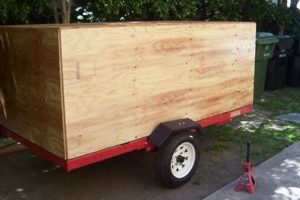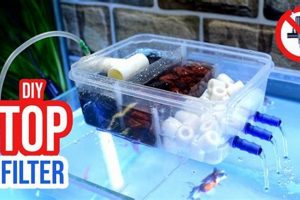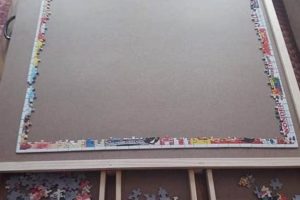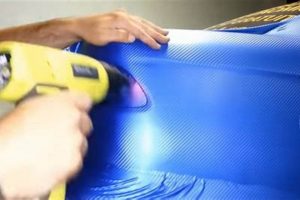The construction of a faux hearth utilizing corrugated fiberboard material represents an accessible and cost-effective approach to simulating a traditional architectural feature. These constructed units, typically assembled from repurposed packaging, aim to replicate the appearance of a functional fireplace without requiring permanent installation or specialized skills. Examples of these creations range from simple, box-like structures to elaborate designs incorporating faux brick patterns and mantels.
The appeal of constructing such a decorative element stems from several factors. It offers an inexpensive method for enhancing the aesthetic appeal of a room, particularly during seasonal celebrations. Furthermore, its temporary nature allows for easy relocation and removal, making it suitable for rental properties or spaces where permanent alterations are not feasible. Historically, similar makeshift architectural elements have been employed in theatrical productions and temporary displays, demonstrating a long-standing tradition of creating illusions through readily available materials.
This exposition will delve into the practical considerations involved in designing and building a simulated hearth. Topics to be addressed include material selection, structural design principles for ensuring stability, and various techniques for achieving a realistic visual presentation. The guide will also cover safety precautions and explore creative customization options for tailoring the finished product to individual preferences and spatial constraints.
Construction Advisories
The following guidelines offer practical advice for the successful design and construction of a simulated hearth. Adherence to these suggestions will contribute to both the aesthetic quality and structural integrity of the finished product.
Tip 1: Material Selection: Prioritize the use of heavy-duty, double-walled corrugated cardboard for primary structural components. Thinner materials may be suitable for decorative elements, but the main supporting structure requires robust materials to prevent collapse.
Tip 2: Structural Integrity: Employ a design that incorporates internal bracing and supports. Triangulation principles can significantly enhance the strength and stability of the structure. Consider adding internal cardboard supports arranged in triangular patterns.
Tip 3: Precise Measurements: Accurate measurements are crucial for a professional-looking result. Use a measuring tape and straightedge to ensure precise cuts and alignment during assembly. Inaccurate dimensions can lead to structural weaknesses and visual imperfections.
Tip 4: Secure Adhesion: High-quality adhesive tape, such as packing tape or duct tape, is essential for secure assembly. Apply tape generously and ensure that all seams and joints are thoroughly sealed. Reinforce critical stress points with multiple layers of tape.
Tip 5: Realistic Detailing: Incorporate realistic details to enhance the visual appeal. Faux brick patterns can be created using paint, stencils, or textured paper. Consider adding a simulated mantel using wooden trim or repurposed cardboard.
Tip 6: Safety Considerations: Exercise caution when using cutting tools. Employ a sharp utility knife and a cutting mat to prevent accidents and ensure clean cuts. Supervise children during the construction process to avoid injuries.
Tip 7: Weight Distribution: If decorative items are to be placed on the simulated mantel, ensure that the weight is evenly distributed to prevent instability. Reinforce the mantel support structure as needed to accommodate the added weight.
By implementing these strategies, a durable and visually appealing simulated hearth can be achieved. Careful planning and execution are paramount to realizing a finished product that effectively replicates the appearance of a traditional fireplace.
The subsequent sections will address design considerations and creative customization techniques to further enhance the realism and aesthetic integration of the constructed element.
1. Material Robustness
Material robustness is a foundational consideration in the creation of simulated hearths from corrugated fiberboard. The selected material directly influences the structural integrity, longevity, and overall aesthetic appeal of the finished product. A thorough understanding of cardboard properties and their impact on the stability of the structure is paramount.
- Cardboard Grade and Thickness
The grade and thickness of the cardboard directly correlate with its ability to withstand stress and maintain its form. Double-walled or triple-walled cardboard, characterized by multiple layers of fluting between liner boards, offers significantly greater resistance to bending and compression compared to single-walled options. The selection of a suitable grade is crucial for preventing structural failure, particularly in larger or more elaborate designs.
- Flute Direction and Orientation
The direction of the flutes within the corrugated cardboard impacts its bending strength. Cardboard is significantly stronger when bent along the axis of the flutes. Consequently, the orientation of the flutes should be strategically considered during construction to maximize the load-bearing capacity of the simulated hearth’s various components, especially for the base and mantel supports.
- Environmental Factors: Moisture and Humidity
Corrugated cardboard is highly susceptible to moisture damage, which can compromise its structural integrity. High humidity or direct exposure to water can weaken the cardboard fibers, leading to deformation and potential collapse. Protective coatings or sealants may be necessary to mitigate the effects of environmental factors, particularly if the simulated hearth is intended for long-term use or display in humid environments. This will also depend on the location of your diy cardboard fireplace.
- Joint Strength and Adhesive Compatibility
The robustness of the constructed structure is directly related to the strength of the joints and the adhesive’s compatibility with the cardboard material. Using an inappropriate adhesive can result in weak bonds that fail under stress. High-quality packing tape, construction adhesives, or hot glue formulated for use with cardboard are recommended for ensuring durable and reliable connections between structural components. A poor choice can result in the entire diy cardboard fireplace falling apart.
In summation, material robustness is an indispensable factor in the successful creation of a durable and aesthetically pleasing simulated hearth using cardboard. Proper selection of cardboard grade, strategic orientation of flutes, protection against environmental factors, and the use of compatible adhesives are crucial for achieving a final product that effectively simulates a traditional fireplace while maintaining structural integrity over time. The durability will be more prominent when compared to one built with low quality
materials.
2. Structural Stability
Structural stability is paramount in the successful construction of a simulated hearth from corrugated fiberboard. Without adequate structural integrity, the constructed unit is prone to collapse, undermining its aesthetic purpose and potentially posing a safety hazard. The following facets delineate key considerations for ensuring a stable and durable build.
- Base Support and Load Distribution
The foundation of any structure dictates its overall stability. In the context of a faux hearth, the base must be capable of supporting the weight of the entire unit, including any decorative elements placed upon the mantel. Distributing the load evenly across the base through internal supports and a wide footprint minimizes stress concentrations that could lead to buckling or collapse. Examples include incorporating internal vertical supports or a wider base than top for better diy cardboard fireplace structural stability.
- Internal Bracing and Reinforcement
Internal bracing is crucial for preventing deformation and maintaining the shape of the structure under stress. Diagonal supports, strategically placed within the frame, resist shearing forces that can cause the unit to lean or collapse. Reinforcing corners and edges with additional layers of cardboard or adhesive tape further enhances rigidity. This bracing ensures the diy cardboard fireplace maintains its form. A real-world example includes the use of triangular supports within a cardboard box to prevent crushing.
- Joint Integrity and Connection Strength
The points where individual cardboard pieces are joined together represent critical weak points in the structure. The method of connection, whether through adhesive bonding or interlocking designs, must provide sufficient strength to withstand applied forces. Overlapping joints and the generous application of high-strength adhesive tape are essential for creating robust connections. A good joint integrity will help the diy cardboard fireplace stand strong.
- Material Fatigue and Long-Term Durability
Even with proper construction techniques, corrugated fiberboard is susceptible to material fatigue over time. Repeated stress or exposure to environmental factors can weaken the cardboard fibers, reducing its ability to support loads. Incorporating design elements that minimize stress concentrations and protecting the structure from moisture can prolong its lifespan. Over time, poor construction could impact the diy cardboard fireplace.
These facets of structural stability are interconnected and contribute to the overall integrity of the simulated hearth. Neglecting any one of these considerations can compromise the entire structure. For example, a robust base is rendered ineffective if the joints are weak, or if the cardboard is allowed to degrade from moisture exposure. Therefore, a holistic approach is required to ensure the creation of a durable and aesthetically pleasing simulated fireplace. Proper planning will make for a better diy cardboard fireplace.
3. Adhesive Integrity
Adhesive integrity constitutes a critical determinant in the structural stability and longevity of a corrugated fiberboard hearth simulation. The effectiveness of the adhesive bond directly influences the ability of the constructed unit to withstand stress, maintain its form, and resist the detrimental effects of environmental factors. Inadequate adhesive integrity precipitates joint failure, leading to structural instability and potentially rendering the faux fireplace unusable. For example, the use of weak glue on the mantel supports will result in sagging or collapse, negating the aesthetic purpose of the structure.
The selection of an appropriate adhesive is contingent upon several factors, including the type of cardboard utilized, the anticipated load on the joints, and the environmental conditions to which the structure will be exposed. Packing tape, hot melt adhesives, and construction-grade adhesives represent viable options, each offering distinct advantages and disadvantages. Packing tape provides ease of application and immediate bonding, but its long-term durability may be limited. Hot melt adhesives offer rapid setting and strong bonding but require specialized application equipment. Construction-grade adhesives, while offering superior bond strength, may necessitate longer curing times. The selection criteria should prioritize maximizing bond strength, ensuring compatibility with cardboard, and minimizing the risk of degradation over time. Properly adhered pieces makes for a stronger diy cardboard fireplace.
In conclusion, adhesive integrity is an indispensable element in the successful creation of a durable and structurally sound simulated hearth. Careful consideration of adhesive selection, proper application techniques, and environmental factors are crucial for maximizing bond strength and ensuring the longevity of the constructed unit. Compromising on adhesive integrity invariably results in a diminished structural lifespan and compromised aesthetic appeal, ultimately detracting from the overall value of the simulated fireplace. Thus, understanding and prioritizing proper adhesion is crucial to a quality diy cardboard fireplace.
4. Dimensional Accuracy
Dimensional accuracy, in the context of constructing a simulated hearth from corrugated fiberboard, denotes the precision and correctness of measurements and cuts applied to the material. This accuracy directly influences the structural integrity, aesthetic appeal, and overall realism of the finished product. Deviations from precise dimensions can compromise structural stability, lead to visual imperfections, and ultimately detract from the simulated hearth’s intended purpose.
- Structural Integrity and Joint Fit
Precise dimensional accuracy is critical for ensuring tight and secure joints. When individual cardboard pieces are cut to exact specifications, they fit together seamlessly, creating a strong and stable structure. Inaccurate cuts can result in gaps or overlaps at the joints, weakening the overall unit and increasing the risk of collapse. For example, a base piece cut too small will not adequately support the upper structure, while pieces cut too large will not align properly, compromising the aesthetic appearance and structural stability. If dimensions are off, the diy cardboard fireplace structure is at risk.
- Visual Realism and Aesthetic Appeal
The aesthetic success of a simulated hearth hinges on its ability to convincingly replicate the appearance of a traditional fireplace. Dimensional accuracy plays a pivotal role in achieving this realism. Precise cuts and accurate proportions create clean lines, smooth surfaces, and a visually appealing overall design. Inaccurate dimensions can lead to distorted shapes, uneven surfaces, and a generally unprofessional appearance. A mantel that’s not level or a firebox that’s not square detracts from the intended illusion. The diy cardboard fireplace has to look the part to truly function as a “fireplace”.
- Efficient Material Utilization and Waste Reduc
tionAccurate measurements and precise cutting techniques minimize material waste. When cardboard pieces are cut according to exact specifications, there is less need for adjustments, corrections, or re-cuts, resulting in more efficient utilization of the raw materials. This is not only cost-effective but also environmentally responsible. Careless cutting will increase the scrap being thrown away. Reducing waste by careful planning makes this diy cardboard fireplace project responsible.
- Ease of Assembly and Construction Time
Precise dimensional accuracy streamlines the assembly process. When all pieces are cut to the correct size and shape, they fit together easily and accurately, reducing the time and effort required to construct the simulated hearth. Inaccurate dimensions, on the other hand, can lead to frustration, delays, and the need for time-consuming adjustments. A properly planned diy cardboard fireplace is much faster and easier to assemble.
In essence, dimensional accuracy is a foundational element in the successful construction of a visually appealing and structurally sound simulated hearth from corrugated fiberboard. By prioritizing precision in measurements and cuts, individuals can ensure the creation of a realistic, durable, and efficient construction project. Accurate dimensions make or break a diy cardboard fireplace.
5. Visual Realism
The attainment of visual realism represents a primary objective in the construction of a simulated hearth using corrugated fiberboard. The degree to which the constructed unit successfully emulates the appearance of a genuine fireplace directly influences its aesthetic value and its ability to serve as a convincing decorative element within a living space.
- Textural Replication
Replicating the texture of traditional fireplace materials, such as brick, stone, or wood, is essential for achieving visual realism. Techniques such as applying textured paint, utilizing stencils to create brick patterns, or adhering faux wood grain paper can effectively simulate the tactile qualities of these materials. The success of this replication hinges on the accurate representation of surface imperfections and variations in color, contributing to a more authentic appearance. A highly realistic diy cardboard fireplace will have great textures.
- Proportional Accuracy
Maintaining accurate proportions is crucial for creating a convincing illusion. The dimensions of the firebox, mantel, and overall structure must align with established architectural standards for fireplaces. Deviations from these proportions can result in a visually distorted and unconvincing representation. For instance, a firebox that is too small relative to the mantel will immediately appear unnatural, undermining the intended aesthetic effect. A well-made diy cardboard fireplace will follow the typical proportions for a real fireplace.
- Lighting Effects and Depth Perception
Strategic use of lighting can significantly enhance the visual realism of the simulated hearth. Incorporating LED lights or reflective materials within the firebox can create the illusion of flickering flames and glowing embers, adding depth and dimensionality to the scene. The interplay of light and shadow contributes to a more realistic and engaging visual experience. Great lighting makes any diy cardboard fireplace more life-like.
- Integration with Surroundings
The successful integration of the simulated hearth with its surrounding environment is paramount for achieving visual realism. The color scheme, style, and materials used in the construction should complement the existing dcor of the room. A simulated hearth that clashes with its surroundings will appear out of place and detract from the overall aesthetic harmony of the space. If the diy cardboard fireplace doesn’t fit the space, it will look out of place.
These elements collectively contribute to the overall visual realism of a simulated hearth. While corrugated fiberboard inherently presents limitations in terms of replicating the weight and solidity of traditional fireplace materials, careful attention to detail and strategic implementation of these techniques can yield a convincing and aesthetically pleasing decorative element. It takes skill to create a diy cardboard fireplace that’s a convincing simulation.
6. Safety Protocols
The construction of a simulated hearth from corrugated fiberboard necessitates adherence to established safety protocols to mitigate potential hazards. While the materials involved are generally considered low-risk, the tools and processes employed in their manipulation can present tangible safety concerns. Failure to observe appropriate safety measures can result in physical injury, property damage, or compromised structural integrity of the constructed unit.
The primary safety considerations revolve around the use of cutting tools, the application of adhesives, and the management of potential fire hazards. Sharp implements, such as utility knives and scissors, are commonly employed to shape and size the cardboard components. Improper handling of these tools can lead to lacerations or puncture wounds. The utilization of adhesives, particularly hot melt adhesives, presents a risk of burns. Moreover, while cardboard itself is not inherently explosive, its combustible nature necessitates careful management of potential ignition sources, especially if the simulated hearth incorporates lighting elements. For instance, improperly wired LED lights could pose a fire risk. Therefore, any electrical components added to the diy cardboard fireplace should be properly insulated and tested to ensure safe operation.
In summary, the construction of a corrugated fiberboard hearth simulation, while seemingly innocuous, requires a conscientious approach to safety. Adhering to basic safety protocols related to tool handling, adhesive application, and fire prevention is essential for ensuring a safe and successful project outcome. Neglecting these considerations elevates the risk of injury and property damage, detracting from the intended benefits of creating a decorative element for home or temporary use. A diy cardboard fireplace should be a source of joy, not danger.
Frequently Asked Questions
The following section addresses common inquiries regarding the construction and use of simulated hearths constructed from corrugated fiberboard, providing factual information and guidance to facilitate informed decision-making.
Question 1: What is the expected lifespan of a simulated hearth constructed from corrugated fiberboard?
The lifespan of a such a hearth varies based on several factors, including the quality of materials used, the level of structural reinforcement, and environmental conditions. Under optimal conditions, with high-grade cardboard and careful construction, a lifespan of several years is possible. However, exposure to moisture or excessive weight can significantly reduce its longevity.
Question 2: Is a corrugated fiberboard hearth simulation suitable for supporting heavy objects on the mantel?
Corrugated fiberboard is not inherently capable of supporting substantial weight. The mantel support structure must be significantly reinforced to accommodate heavier objects. Distributing the weight evenly and
limiting the total load are critical considerations. Without sufficient reinforcement, the mantel is prone to collapse.
Question 3: Can a simulated hearth constructed from corrugated fiberboard be safely used with a real flame?
Corrugated fiberboard is a combustible material, and direct contact with an open flame poses a significant fire hazard. It is imperative to never use a real flame in or near a such a hearth. Electric candles or LED lighting are safer alternatives for simulating a fire.
Question 4: How can the appearance of a simulated corrugated fiberboard hearth be enhanced to increase its realism?
Several techniques can enhance visual realism, including applying textured paint, using stencils to create brick or stone patterns, and incorporating faux wood trim. Strategic use of lighting can also create the illusion of depth and warmth. The application of these techniques requires careful attention to detail and artistic skill.
Question 5: What is the recommended method for disposing of a corrugated fiberboard hearth simulation at the end of its useful life?
Corrugated fiberboard is generally recyclable. The constructed unit should be disassembled, and the cardboard components should be flattened and placed in designated recycling bins. Local recycling guidelines should be consulted for specific instructions.
Question 6: What are the primary advantages of using corrugated fiberboard to construct a simulated hearth compared to other materials?
The primary advantages include cost-effectiveness, ease of construction, and availability of materials. Corrugated fiberboard is significantly less expensive than traditional fireplace materials, requires minimal specialized tools or skills to work with, and is readily accessible in most locations.
In summary, a corrugated fiberboard hearth simulation offers a temporary and affordable alternative to a traditional fireplace. However, it is crucial to understand the limitations of the material and to adhere to safety guidelines to ensure a positive and risk-free experience.
The subsequent section will provide instructions for building a simulated hearth.
Conclusion
This exposition has detailed the considerations essential to the creation of a “diy cardboard fireplace.” From material selection and structural stability to visual realism and adherence to safety protocols, the process necessitates careful planning and execution. The inherent limitations of corrugated fiberboard must be acknowledged and addressed through appropriate design choices and construction techniques to achieve a satisfactory outcome.
The decision to undertake a “diy cardboard fireplace” project should be informed by a realistic assessment of the desired aesthetic and the available resources. While a complete replication of a traditional fireplace is unattainable, a thoughtfully constructed simulation can serve as a temporary and cost-effective decorative element. Responsible construction, prioritizing safety and material limitations, is paramount.







